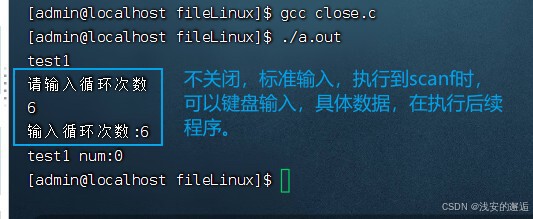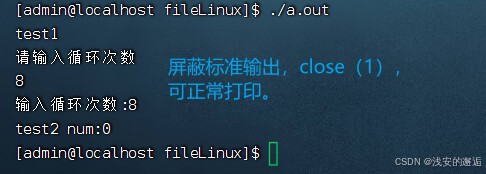1.标准IO 和 文件IO 的区别
1.1标准IO(fopen、fclose等)
- 是库函数
- 是对系统调用的封装
- 标准IO有缓存
1.2文件IO(open、close、write、read)
- 是系统调用
- 是Linux内核函数接口
- 文件IO没有缓存
标准IO对文件IO进行了封装,标准IO库函数是构建于文件IO这些系统调用之上的。例如:标准IO库函数fopen,就利用系统调用文件IO的open函数来执行打开文件的操作。
可移植性:标准IO有更好的可移植性。
性能、效率:标准IO库在用户空间维护了自己的stdio缓冲区,所以标准IO带有缓冲区,文件IO在用户空间是不带缓存的。标准IO在性能效率上要优于文件IO。
注:Linux系统下的man手册使用
man 1 ls //数字1表示查看Linux命令
man 2 open //数字2表示查看系统调用函数
man 3 fopen //数字3表示查看标准C库函数
2.open打开文件
功能:
打开文件,并获得文件描述符
函数原型:
#include <sys/types.h>
#include <sys/stat.h>
#include <fcntl.h>/* 参数:pathname: 文件路径。
flags: 标志位,控制打开方式。O_RDONLY 只读O_WRONLY 只写O_RDWR 读写O_APPEND 追加O_CREAT 创建O_TRUNC 清0O_ASYNC 异步IOO_NONBLOCK 非阻塞IO mode: 创建文件时的权限(需与O_CREAT一起使用)4:读权限(r),2:写权限(w),1:执行权限(x)例如:664:表示本人权限读写,同组人权限读写,其他人仅读权限返回值:成功返回新文件描述符失败返回-1 文件描述符:很小的非负整数 0 1 2 3 .. 0-1023新生成的文件描述符永远为最小的非负整数*/int open(const char *pathname, int flags);
int open(const char *pathname, int flags, mode_t mode);fopen 与 open 函数读写、执行对应关系:
fopen调用: open调用:
"r" -》 O_RDONLY
"r+" -》 O_RDWR
"w" -》 O_WRONLY | O_CREAT | O_TRUNC, 0664
"w+" -》 O_RDWR | O_CREAT | O_TRUNC, 0664
"a" -》 O_WRONLY | O_CREAT | O_APPEND, 0664
"a+" -》 O_RDWR | O_CREAT | O_APPEND, 0664
2.1 open打开文件及返回值结果验证
程序:
#include <sys/types.h>
#include <sys/stat.h>
#include <fcntl.h>
#include <stdio.h>int main(int argc, const char *argv[])
{int fd = 0;close(0);while (1){//只写打开文件,不存在创建,存在清0fd = open("./file.txt", O_WRONLY | O_CREAT | O_TRUNC, 0664);if (-1 == fd){perror("fail to open");return -1;}printf("fd = %d\n", fd);}return 0;
}运行结果:(1)文件清0验证


(2)返回值验证

3.close关闭文件
功能:
用于关闭已打开的文件描述符,释放系统资源并确保数据同步
函数原型:
#include <unistd.h>/*
参数:fd:要关闭的文件描述符(由open()、pipe()、socket()等函数返回。返回值
成功:返回0。
失败:返回-1,并设置errno(如EBADF、EINTR等)
*/int close(int fd);
3.1Linux标准输入、输出、错误
在Linux系统中,输入输出(I/O)是程序与外部设备(如键盘、显示器、文件等)交互的基础。Linux提供了几种标准方法来处理输入输出,主要包括以下几种:
- 标准输入(Standard Input, 简称stdin):通常指的是文件描述符0,用于程序接收外部输入。例如,键盘输入。(0 :标准输入)
- 标准输出(Standard Output, 简称stdout):通常指的是文件描述符1,用于程序向外部输出信息。例如,控制台输出。(1 :标准输出)
- 标准错误(Standard Error, 简称stderr):通常指的是文件描述符2,用于程序向外部输出错误信息。(2 :标准错误)
3.2 close函数验证
3.2.1close函数关闭标准输入(0)
程序:
#include <sys/types.h>
#include <sys/stat.h>
#include <fcntl.h>
#include <unistd.h>
#include <stdio.h>int test1()
{printf("test1 \n");int fd = 0;close(0); //关闭标准输入,键盘不能输入printf("请输入循环次数 \n");scanf("%d", &fd);printf("输入循环次数:%d \n",fd);return 0;
}int main(int argc, const char *argv[])
{int num = test1();printf("test1 num:%d \n",num);return 0;
}运行结果:(1)程序:不屏蔽,执行 close(0);

(2)程序:屏蔽,不执行 close(0);

3.2.2 close函数关闭标准输出(1)
程序:
#include <sys/types.h>
#include <sys/stat.h>
#include <fcntl.h>
#include <unistd.h>
#include <stdio.h>int test2()
{printf("test1 \n");int fd = 0;//close(1); //关闭标准输出,终端不能输出打印数据printf("请输入循环次数 \n");scanf("%d", &fd);printf("输入循环次数:%d \n",fd);return 0;
}int main(int argc, const char *argv[])
{int num = test2();printf("test2 num:%d \n",num);return 0;
}运行结果:(1)程序:不屏蔽,执行 close(1);

(2)程序:屏蔽,不执行 close(1);

3.2.3 close函数关闭标准出错(2)
程序:
#include <sys/types.h>
#include <sys/stat.h>
#include <fcntl.h>
#include <unistd.h>
#include <stdio.h>int test3()
{printf("test3 \n");int fd = 0;close(2); //关闭标准出错,终端不能输出错误信息//只写打开文件,不存在创建,存在清0//fd = open("./file2.txt", O_WRONLY | O_CREAT | O_TRUNC, 0664);//只读打开file2.txt ,目录下并没有该文件fd = open("./file2.txt", O_RDWR);if (-1 == fd){perror("fail to open file ");return -1;}return 0;
}int main(int argc, const char *argv[])
{int num = test3();printf("test3 num:%d \n",num);return 0;
}
运行结果:(1)程序:屏蔽,不执行 close(2);
出错信息正常打印了:fail to open file : No such file or directory
 (2)程序:不屏蔽,执行 close(2);
(2)程序:不屏蔽,执行 close(2);
test3(); 执行后,返回值为 -1 ,已出错。未打印出错信息。















